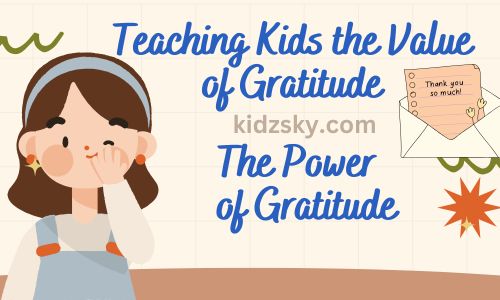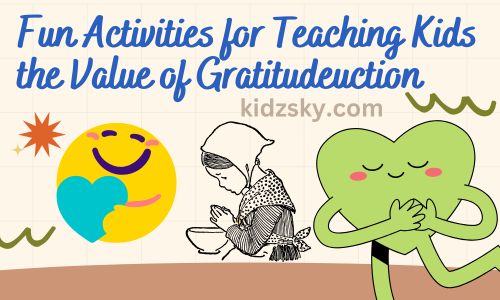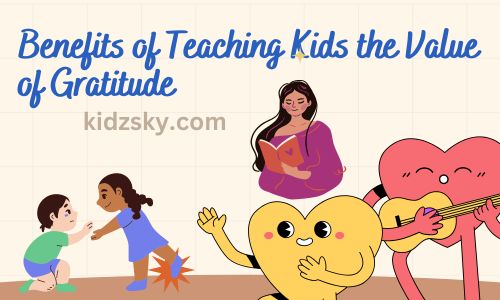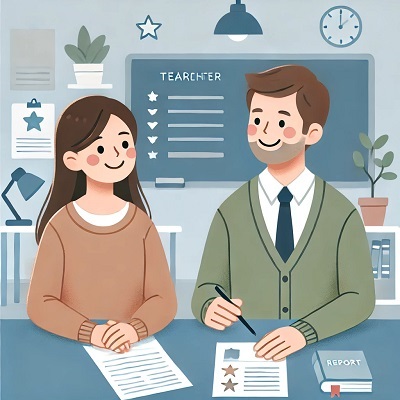Gratitude is a fundamental value that helps us appreciate the good things in lifeTeaching kids the value of gratitude can shape them into more thoughtful, empathetic, and joyful individuals.
When children learn to value gratitude, they develop a mindset of appreciation, which can positively impact their relationships, emotional resilience, and overall outlook on life.
In this blog, we’ll explore why gratitude is vital for children, effective ways of teaching kids the value of appreciation, and how to make it a lasting habit through fun activities, real-life examples, and daily practices.

Why Is Teaching Kids the Value of Gratitude Important?
Gratitude is more than just saying “thank you.” It involves recognizing the good in life, understanding the effort behind what we receive, and feeling genuinely appreciativeWhen kids learn the value of gratitude, they gain a positive outlook, are more resilient to challenges, and form better relationshipsLet’s look at the benefits of teaching kids the value of gratitude:
- Enhanced Empathy: Gratitude teaches kids to be mindful of others’ efforts, which promotes kindness and empathy.
- Stronger Relationships: A grateful child appreciates others, leading to stronger friendships and better family bonds.
- Improved Mental Health: Studies show that people who regularly express gratitude experience more happiness and less stress, which also applies to kids.
- Resilience: Gratitude helps children see the positives even in tough times, making them more resilient.
How to Start Teaching Kids the Value of Gratitude
To make gratitude a natural part of a child’s life, start with simple practices and gradually build these habits into their routineHere are some actionable steps for teaching kids the value of gratitude:
1Lead by Example
Children often mimic the behavior they see in adults, especially parentsYour child will learn to do the same when you express gratitude regularly.
- Example: When you receive help, say, “I’m grateful for your help,” or mention how happy you are to have supportive people.
- Action Tip: Share daily what you’re thankful for, creating a gratitude-oriented home environment.
2Create a Daily Gratitude Routine
Establishing a regular practice can make gratitude a habitCreate a simple routine, like expressing three things each family member is thankful for before bedtime.
- Example: During dinner, each person shares one thing they’re grateful for that day.
- Tip: Encourage your child to think of small things, like a fun game they played or a sunny day, to show them that gratitude doesn’t have to be grand.
3Practice Gratitude Journaling
Encourage kids to keep a gratitude journal where they write or draw what they’re thankful forThis helps them reflect on the positives in their life.
- Example: Ask your child to write down or draw something they’re grateful for daily, like a hug from a friend or a favorite meal.
- Tip: If they’re too young to write, they can draw pictures or tell you, and you can write it for them.
4Encourage Thank-You Notes
Writing thank-you notes teaches kids to acknowledge others’ effortsThis simple practice makes them more mindful of the people around them and the kindness they receive.
- Example: After receiving gifts, guide your child to write thank-you notes to each person, explaining why they appreciate the gift.
- Action Tip: Help them understand the purpose behind the note, not just the act of writing itThis can make the lesson more meaningful.
For Parents:- The Benefits of Positive Parenting: Brighter Future of Child

5Volunteer Together
Volunteering is an impactful way to teach kids the value of gratitude by helping them understand the importance of giving back.
- Example: Participate in a community clean-up, visit an animal shelter, or volunteer at a food bankExplain to your child why it’s important to contribute and give to others.
- Tip: Discuss how fortunate you are to have resources and how some people are less fortunate, making it a lesson in appreciation.
6Create a “Gratitude Jar”
This fun activity lets kids see all the good things happening in their livesPlease write it down on paper each time something good happens and put it in a jar.
- Example: Write down small joys like “playing in the park” or “getting a new book” and review the notes together monthly.
- Tip: Encourage them to add to the jar whenever they feel happy or grateful, reinforcing the practice.
7Share Stories of Gratitude
Use stories, books, or movies to illustrate the concept of gratitudeStorytelling helps kids relate to characters and understand the value of gratitude through relatable examples.
- Example: Books like The Thankful Book by Todd Parr or Gratitude Soup by Olivia Rosewood help introduce kids to gratitude engagingly.
- Tip: After the story, ask your child to name one thing they’re grateful for to reinforce the lesson.

Real-Life Examples of Gratitude
Incorporate real-life examples to make the idea of gratitude relatable for kidsShow them situations where gratitude made a positive difference.
- Helping Others: Explain how a friend might appreciate a small act of kindness, like sharing a toy, and how that strengthens friendship.
- Thanking Family Members: Encourage them to thank siblings, parents, or grandparents for specific acts, like making meals or helping with homework.
- Recognizing Everyday Helpers: When visiting a store, prompt your child to thank the cashier, showing respect and appreciation for everyday services.
Example: Point out how thanking a teacher for their hard work can make them feel valued, teaching your child how impactful gratitude can be.
Kids Activity:- The Benefits of Gardening with Kids: 7 Skills & Fun Together

Fun Activities for Teaching Kids the Value of Gratitude
Making gratitude a fun, engaging activity ensures that kids learn while enjoying the processHere are a few activities to try:
1Gratitude Scavenger Hunt
Create a list of things to find that make your child happy, like something they love to smell, something soft, or something that makes them smile.
- Tip: Use the list to guide a discussion on why each item makes them feel grateful.
2“Thank You” Role-Playing
Role-playing different scenarios, like thanking a friend or a family member, helps kids practice gratitude in a fun and safe environment.
- Example: Pretend to be a friend who lent them a book, and let them practice saying “thank you” and explaining why they appreciated the gesture.

Making Gratitude a Lasting Habit
Teaching kids the value of gratitude is not a one-time effort; it’s a lifelong skill that requires reinforcementHere are a few ways to make gratitude a natural part of their personality:
- Consistency: Practice gratitude daily, even in small ways.
- Reinforcement: Acknowledge and praise your child when they show gratitude.
- Model Gratitude: Show appreciation in everyday interactions, demonstrating gratitude’s value.
Best With Family:- Creating a Family Reading Corner: 5 Step-by-Step Best Guide

Benefits of Teaching Kids the Value of Gratitude
Embracing gratitude has lifelong benefits, impacting both personal happiness and social interactionsBy teaching kids the value of appreciation, you’re helping them grow into compassionate, resilient adults who can appreciate life’s ups and downs.
1Increased Happiness and Positivity
Kids who practice gratitude tend to be happier as they focus on what they have rather than what they lackThis positive outlook can carry them through challenging times, building emotional resilience.
2Improved Relationships
Grateful kids are more likely to appreciate others’ efforts, strengthening friendships and family bondsWhen they see and appreciate what others do for them, they’re more likely to reciprocate with kindness and respect.
3Enhanced Empathy and Compassion
Gratitude fosters empathy, making children more sensitive to others’ needs and experiencesTeaching kids the value of appreciation makes them more understanding and compassionate individuals.
4Better Mental Health
Gratitude has been linked to lower stress, improved sleep, and greater overall well-beingThis extends to kids, creating a foundation for better mental health.
Conclusion
Teaching kids the value of gratitude is an invaluable gift that shapes their character, relationships, and mental outlookGratitude instills positivity, resilience, and empathy, giving children a deeper appreciation for life’s simple joys.
By incorporating gratitude practices, setting examples, and making it a daily habit, you can help your child embrace gratitude in a way that lasts a lifetime.
Embrace these practices today to create a world of appreciation, kindness, and respect, starting right in your home.
Admin creates all Photos used in this blog in Canva.




[…] Best Habits:- Teaching Kids the Value of Gratitude: 7 Best Lifelong Gift […]
[…] Best Habits:- Teaching Kids the Value of Gratitude: 7 Best Lifelong Gift […]
[…] Best Habits:- Teaching Kids the Value of Gratitude: 7 Best Lifelong Gift […]
[…] Best Habits:- Teaching Kids the Value of Gratitude: 7 Best Lifelong Gift […]